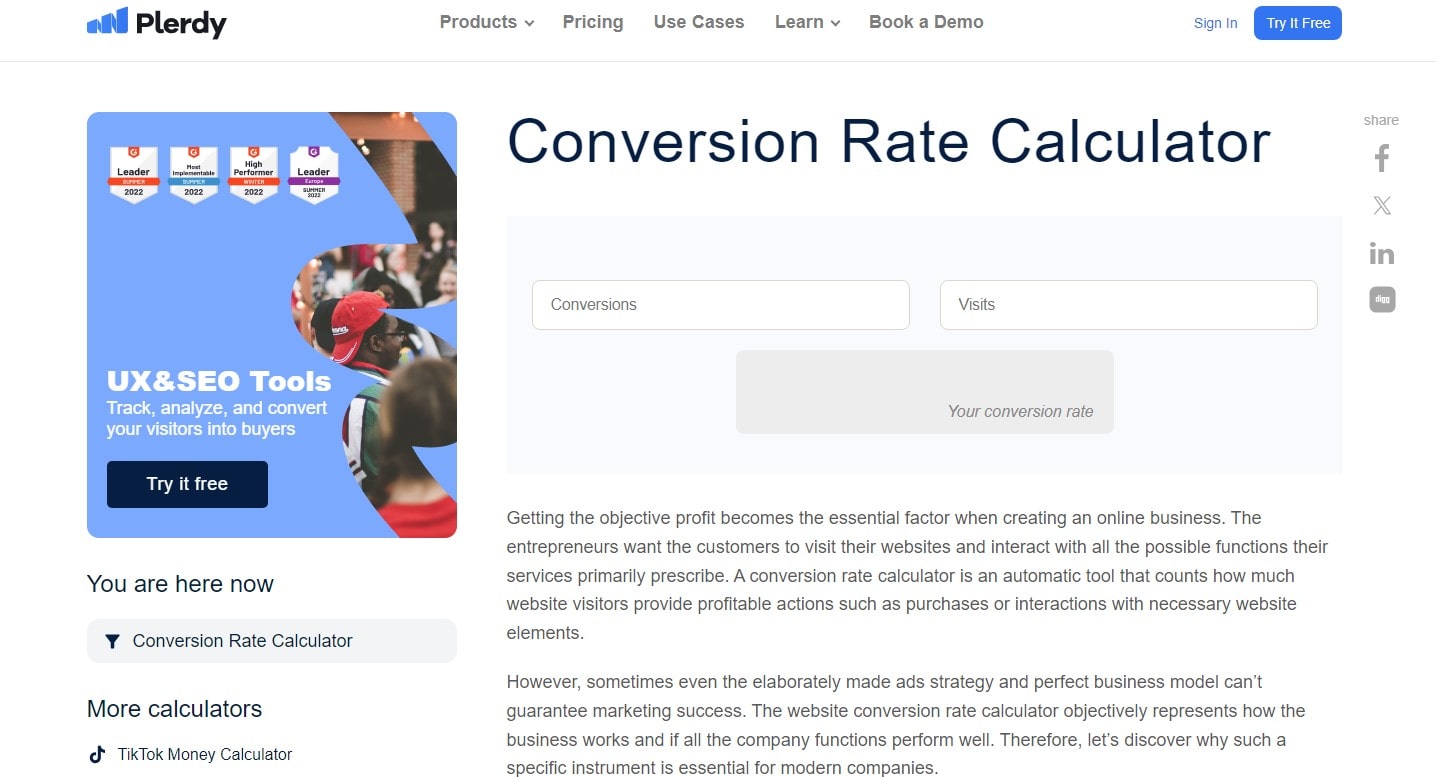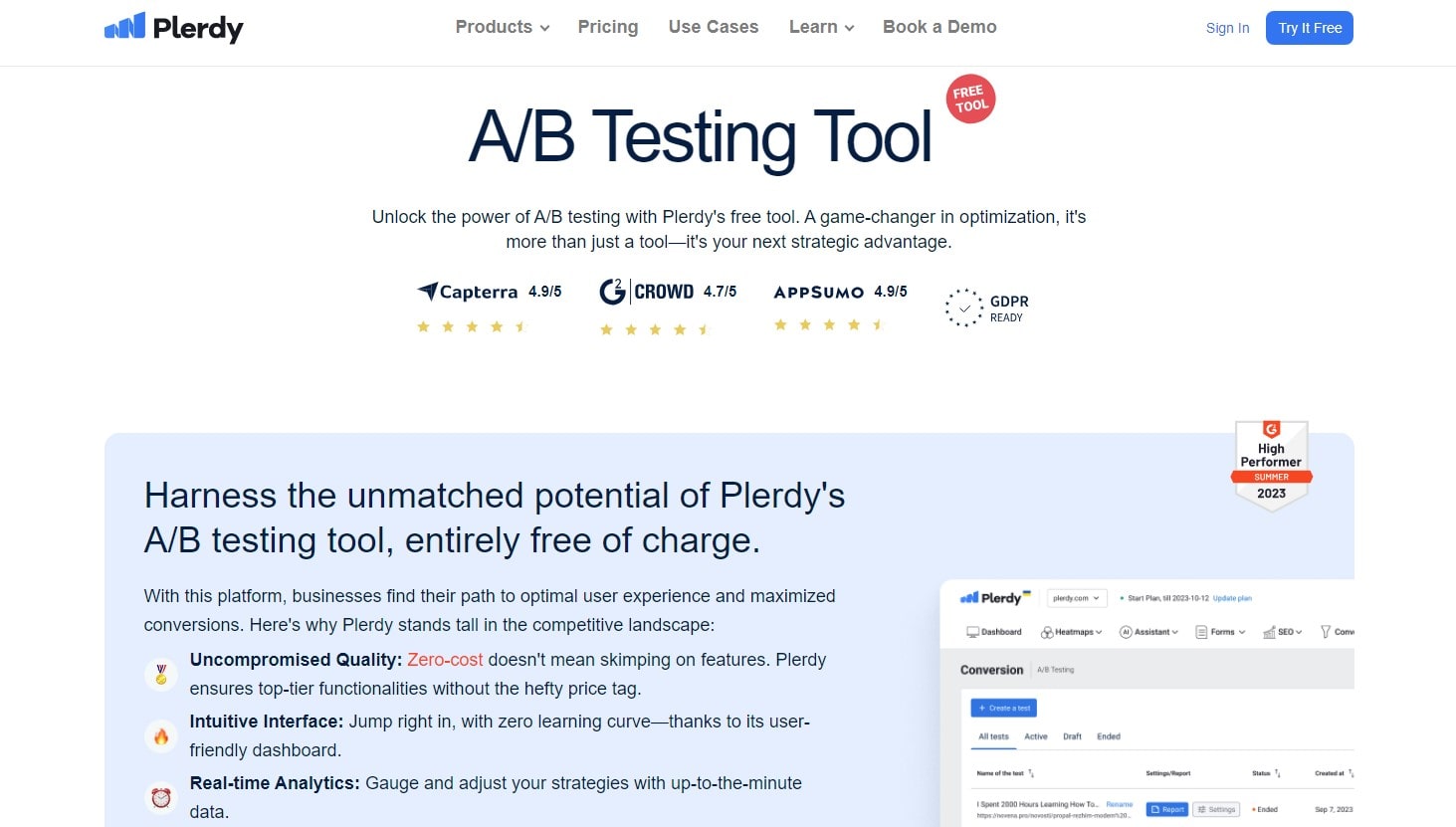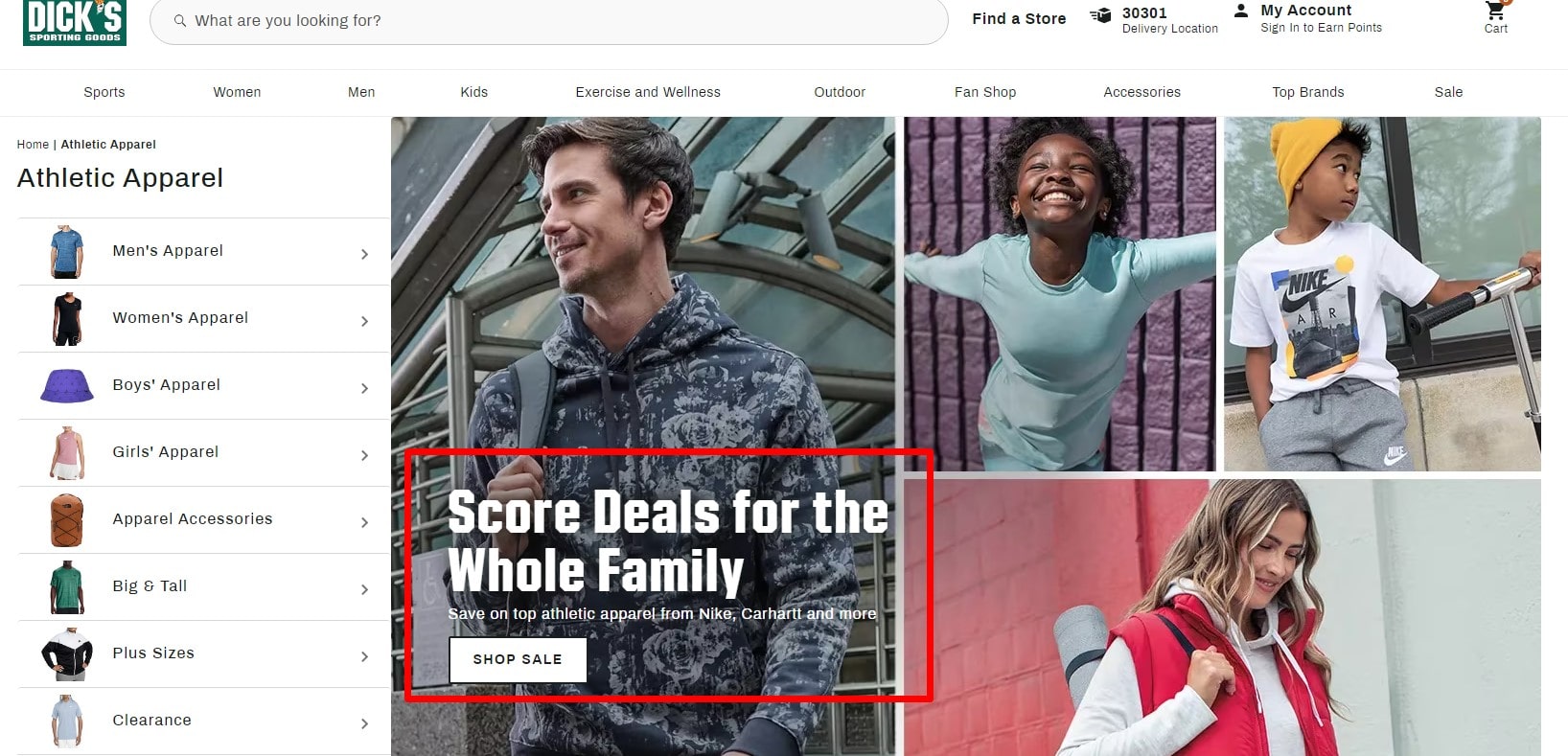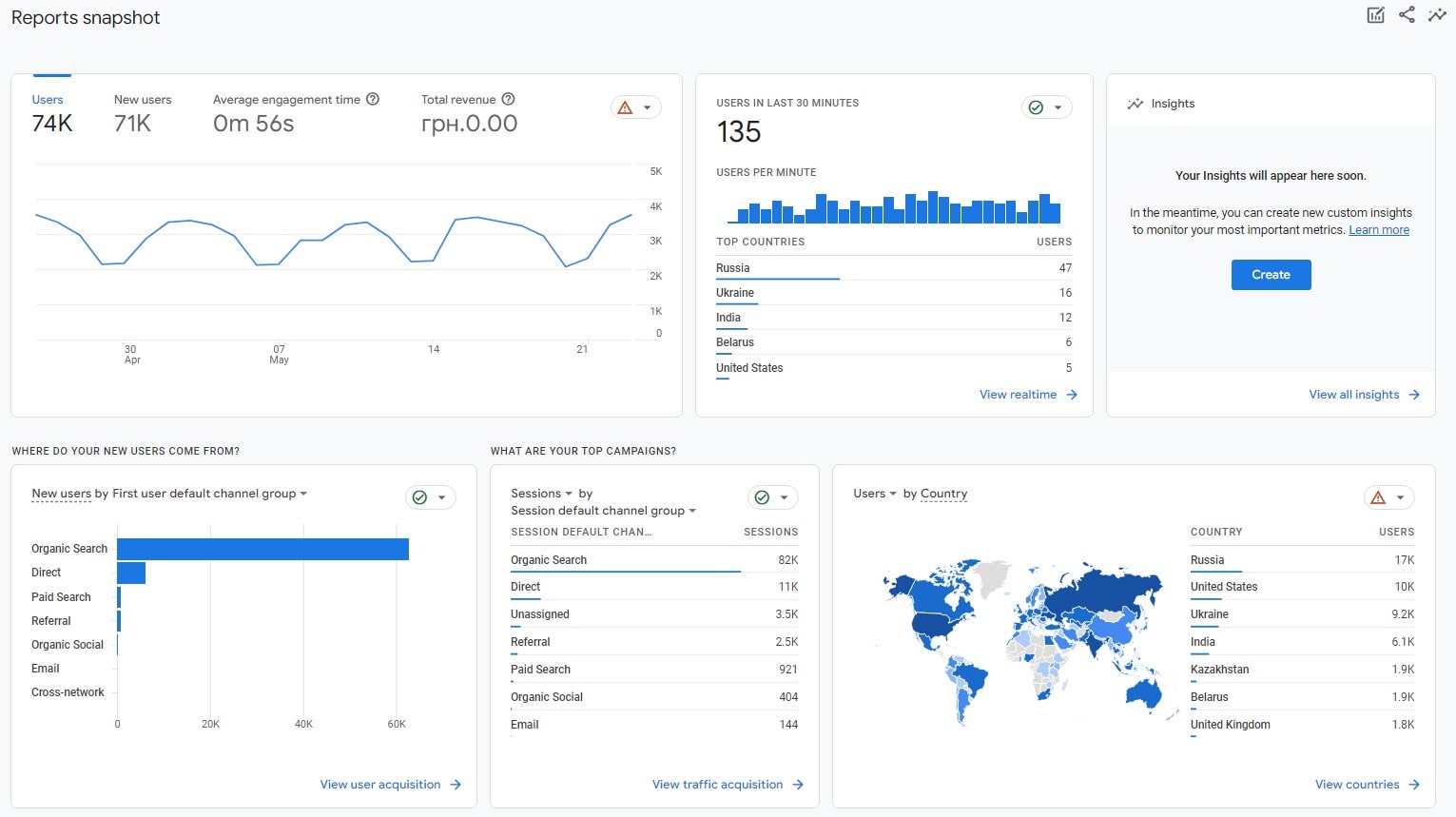Turning directly into the core of digital marketing, one important concept that comes out really clearly is conversion rate Every click and scroll helps conversions to define online success. Not only a jargon, conversion rate highlights the potency of marketing plans and initiatives. Think this out:
- Every action a user takes—from sign-ups to purchases—is a conversion.
- For companies, measuring the percentage of visits that convert is absolutely crucial.
Marketers planning to improve this rate are abound on the digital scene. But just what is a conversion rate exactly? It is the proportion of users of a website who either make a purchase, register for a newsletter, or otherwise fulfill a purpose.
For those driven to improve conversion rates, the Plerdy tool is a pillar for CRO & UX—empowering you with insights to hone and redesign. All set to untangle the core of conversion rate and guide your plans in the correct path? Enter dive in!
Definition of Conversion Rate
Knowing the word “conversion rate” is absolutely essential in the digital marketplace. Simply said, the conversion rate is the proportion of users of a website who perform a desired action—that is, either downloading a resource, purchasing, or newsletter registration.
To disassemble it:
- Conversion: A good activity a visitor of a website does.
- Rate: The frequency of such acts in relation to the overall visitor count.
In the e-commerce market, for example, the conversion rate for sales is 5% if 100 individuals visit a shoe store online and 5 of them purchase a pair of shoes. In a SaaS niche, on the other hand, the rate can be reflective of software downloads or trial sign-ups.
But why then is the conversion rate important? In the terrain of internet marketing, it is a vital statistic. A greater conversion rate shows that more people value a site or service, thereby indicating a strong blend of a convincing offer and a good presentation. On the other hand, a low rate can point to a mismatch between what the site provides and visitor expectations.
Through constant optimization and improvement of site content, design, and user experience, companies can increase their conversion rates, therefore improving the outcomes from the same volume of traffic.
The conversion rate indicates how effectively a website fits audience needs, not only a statistic.
Importance of Conversion Rate in Digital Marketing
Among the many measurements in the busy field of digital marketing, the conversion rate becomes rather important. Driving a spike of traffic to a website is only one aspect; another is making sure this traffic does significant activity. This behavior, sometimes known as a conversion, could range from a basic newsletter sign-up to a purchase.
The conversion rate magnifies the digital initiatives of a brand as follows:
- Measurable ROI: Measurable return on investment is directly correlated with a higher conversion rate. If an e-commerce platform raises its rate, for example, it results in higher sales without raising ad expenditure.
- User Experience Insight: Monitoring the conversion rate helps companies to pick important hints regarding consumer happiness. A slow down in the rate could indicate user journey difficulties, which would call for required improvements.
- Budget Allocation: Understanding the conversion rate helps companies to properly allocate their money. While unsuccessful efforts might call for a review, a campaign that results in outstanding rates calls for greater spending.
A good conversion rate in niches like online learning could indicate more course sign-up. In hospitality, it might refer to more room bookings. Whatever the niche, a good conversion rate guarantees that every time digital marketing initiatives hit the mark rather of just throwing darts in the dark.
Calculating Conversion Rate

One statistic jumps out among the others when negotiating the busy channels of digital commerce: conversion rate. Any effective campaign’s pulse is its litmus test—that which distinguishes good from poor efforts. So let’s start right into the arithmetic of it and then sort through actual cases.
Basic Formula for Calculating Conversion Rate:
- First step: count the effective conversions.
- Second step: split by the overall guest count.
- To get the percentage, multiply the outcome by 100 in third step.
Real-World Examples:
- Online business Elegance: Imagine a fashion store gets one thousand daily visits. Should 50 of them buy, the conversion percentage moves in a clean five percent.
- Sensation of Subscription: Access an online magazine. If forty people sign up for the annual subscription, the conversion rate comes in at five percent given 800 daily visitors.
- App Acquisition: For a mobile app offering, let’s suppose 200 end customers land on the download page out of 2,000 total consumers. The rate is: a clear 10%.
Focusing on conversion rate helps companies to learn important lessons. They can evaluate their calls-to- action’ clarity, determine the general customer contentment, and analyze the attractiveness of their products. Brands changing their approaches have to retain this calculation in their toolkit. Ultimately, knowing the conversion rate is about creating a road to digital excellence rather than only about numbing calculations.
Factors Affecting Conversion Rate
Having a great conversion rate is an art molded by several components; it does not depend on chance. Knowing these elements is essential for companies trying to maximize conversions and optimize their efforts in the digital marketing scene.
- Website Design and User Experience (UX): Creating a beautiful website design combined with a flawless UX is really vital. A gourmet food online store with fast loading times, vivid visuals, and easy navigation would automatically have a greater conversion rate. Simple enough: users who love the ride are more likely to buy.
- Standard of Traffic Source Quality: Traffic is not all made equal. Working with a celebrity, an online fitness program might propel tons of people through. Still, the conversion rate can drop if these guests are not really motivated in fitness. Conversely, targeted marketing attracts to an audience more likely to convert.
- Call to action (CTA) Clarity: All the difference can be created by a strong CTA. Think of a digital art forum. Should their main CTA fall between “Join Now” and “Learn More,” users could wander off. But a sharp, forceful “Dive into Digital Art Today!” can explode conversions.
- Social proof and trust elements: Customers turn to brands they know they trust. An online jewelry store displaying real evaluations, certifications of authenticity, and testimonies will surely observe a change in their conversion rate. In the era of digital mistrust, conversion success depends mostly on trust.
All things considered, marketers have to combine design quality, exact targeting, clear communication, and relentless trust even as they pursue the elusive high conversion rate. Conversion successes are set up by this confluence of elements.
The Difference Between Micro and Macro Conversions
Knowing the subtleties between micro and macro conversions might change the success of a brand in the complex dance of digital analytics. These words, most important in the terrain of conversion rates, direct tactics and improve targeting efforts.
Micro Conversions:
Usually considered as the first steps toward a main objective, micro conversions can include:
- Newsletter subscription.
- Interacting with a chatbot.
- Ordering a free e-book.
This might translate for an e-commerce site into a customer saving an item for their wish list.
Macro Conversions:
Here the focus is most clearly shining. Macro conversions best capture the main goals of a website:
- Closing a purchase of a product.
- Signing up for a premium service.
- Making a scheduled visit.
Think of a travel website where a macro conversion represents a booked trip.
Significance of Monitoring Both:
Although macro conversions are obviously the main successes, undervaluation of micro conversions would be a mistake. Keeping both provides a whole picture of the consumer trip. A course purchase would be considered a macro conversion on an online coaching platform. But knowing the minor steps—perhaps a user choosing a free trial—helps hone tactics and get approaches closer to ideal conversion rates.
Companies trying to improve their digital strategy shouldn’t only pursue the large returns. Embracing both micro and macro conversions can help them create a more educated, comprehensive plan, therefore increasing their conversion rate and strengthening their relationships with their audience.
Techniques to Improve Conversion Rate

A/B Testing and Multivariate Testing
Two strong methods marketers use to increase conversion rate are multivariate testing and A/B testing. Given the increase in digital competition, it is imperative to find what appeals to viewers. In A/B testing, two versions—say, version A and version B—are compared to find which drives more conversions. For a skincare brand, this could mean trying two separate landing page designs to see which one increases sign-ups or sales.
Conversely, multivariate testing probes farther down. Rather than evaluating only two aspects, it evaluates several factors concurrently to find the mix that best increases the conversion rate. Imagine an online bookshop testing:
- Colors schemes.
- Location of best-sellers.
- Font designs.
By means of collective analysis of these factors, the company can shape the ideal homepage design to increase its conversion rate. By using both testing techniques, companies can adjust their plans and make sure every digital touchpoint is ready for best conversion. Throwing yourself into these tests will help you to flourish in a digital environment full of always changing user tastes.
Implementing Clear and Engaging CTAs

Learning the craft of clear, interesting CTAs will greatly increase your conversion rate. A strong CTA invites your viewers to delve further into your offerings, not only calls for a click. Think of a premium hotel chain: they might make use of “Experience Elegance Today” rather to a boring “Book Now.” This not only excites but also vividly depicts what is to come.
Review these CTA techniques to increase your conversion rate:
- Get Action Words Choose verb forms that inspire excitement. A luxury coffee establishment might choose “Savour the Richness” above a basic “Buy Now”.
- Emotionally resonant Stir Emotion CTAs can boost conversion. A pet adoption site might make use of “Give a Furry Friend a Home”.
- Use Numbers. Clearly state the advantages. To clearly state expectations, a fitness app can say “Shed 10 lbs in 30 Days”.
Implementing CTAs that appeal will help companies maximize their digital touchpoints so that viewers are enthralled and pushed towards positive behavior, hence increasing the remarkable conversion rate.
Enhancing Page Loading Speed
Quick page loading is not just a courtesy but also a need for increasing your conversion rate. Customers in the digital economy of today are restless. For example, if their elegant outfit pictures take an eternity to show, a boutique online clothing business could lose possible sales. It immediately affects the conversion rate, which forces consumers toward faster rivals.
Use these strategies to increase your page speed and hence improve your conversion rate:
- Size down high-resolution photographs without sacrificing quality by compression. A gourmet bakery should highlight its pastries, but not with pictures that pull down load times.
- Simplify the codes. Eliminate extraneous characters and line breaks to create leaner code.
- Store elements of your page so that returning visitors may access your site faster.
Learning these techniques not only improves the performance of your website but also drastically improves user experience, so increasing your conversion rate sky-high. Every millisecond cut off increases the success of your site by ensuring digital dominance.
Utilizing Personalization and Segmentation
Leveraging segmentation and customisation has great power for increasing conversion rates. Customized experiences really connect and transform casual guests into devoted consumers. Imagine a hiker finding a site and being immediately met with gear recommendations and trail advice—this tailored approach sends the conversion rate soaring.
Smartly combining segmentation and personalizing to increase your conversion rate calls for:
- Data Dive: Ex probe consumer preferences and behaviors. Should a luxury watch store find a market for older timepieces, create collections to suit that inclination.
- Dynamic content display: Change site components in response to user activities. For one user, a music platform might highlight jazz songs; for another, hard rock.
- Feedback Loops: Analyze trends, hone plans, and increase outputs via feedback loops. A coffee subscription could change offers depending on taste tests.
Using these methods not only generates positive experiences but also pushes the needle on the conversion rate of your site, thereby ensuring that your digital platform really stands out in the saturated market.
Monitoring and Analyzing Conversion Rates

Any digital project aiming at success must be closely watched for conversion rates. Knowing which KPIs to monitor, the tools that provide priceless insights, and how to evaluate the gathered data will help you to translate simple numbers into active plans as you enter this metrics-driven field.
To zero in on conversion rates and their consequences, take under account:
Pivotal KPIs
- High bounce rates often indicate that visitors are not finding resonance on your landing page.
- Cost per Conversion Rates the effectiveness of your marketing initiatives.
- Page Value Pinpoints showing which pages drive conversion of visitors.
Essential Tools
- Google Reports Considered a pillar of tracking website data, it divides user interactions, traffic sources, and—of course—conversion rates.
- Prerdy See users click, move, and scroll distances.
Data Decoding
- Division Breakdown in Segments Review conversion rates for several audience groups. Perhaps your tech pieces attract more converts than your lifestyle pieces.
- Traffic Source Study Tell whether direct traffic, social media, or organic searches increase conversions.
Learning the art of tracking and decoding conversion rates is about knowing what those numbers mean and adjusting plans, not only about gathering numbers. Using these insights can help you to maximize engagement, inspire user behavior, and raise your conversion rate to amazing degrees.
Common Mistakes in Conversion Rate Optimization (CRO)
A few mistakes in the fast-paced field of conversion rate optimization can stop your momentum. Let’s explore certain traps that, avoided, might magnify your efforts at optimization.
- Fallacy: “Set It and Forget It” One common mistake is not testing often. Depending too much on old data or historical performance could let you miss changing user behavior or new trends. E-commerce sites, for example, have to adjust to seasonal trends, holiday shopping practices, or even brief fads.
- Mobile Experience Vision: Ensuring a flawless mobile experience is non-negotiable in a digital age where mobile users rule. If not mobile-friendly, an online clothing company could turn away a possible customer simply because they couldn’t enlarge on a fabric detail.
- Content complacency is: It is a myth that the conversion rate depends just on the design. Especially important is interesting, pertinent material. Ignoring to update stories with the most recent industry advancements, a tech blog runs the danger of losing credibility and, so, conversions.
Sidestep these traps to optimize your CRO. These pillars will guarantee that your conversion rate not only increases but also thrives by means of regular testing, mobile experience optimization, and content dynamism.
FAQ: What is Conversion Rate?
What is a conversion rate, and why is it important?
The conversion rate is the percentage of website visitors who complete a desired action, such as making a purchase or signing up for a newsletter. It’s a crucial metric because it reflects how effectively your website engages visitors and drives results. A higher conversion rate means better ROI and optimized marketing efforts.
How can I calculate my website’s conversion rate?
To calculate the conversion rate, use this simple formula:
(Number of conversions / Total visitors) × 100
For example, if 500 users visit your website and 25 make a purchase, your conversion rate is 5%. Monitoring this metric helps refine marketing strategies for better performance.
What factors affect my conversion rate?
Several key elements influence conversion rates, including website design, user experience (UX), page loading speed, and the clarity of your call-to-action (CTA). High-quality traffic and trust-building elements, such as customer reviews, also play a significant role in increasing conversions.
How can Plerdy help improve my website’s conversion rate?
Plerdy offers tools for Conversion Rate Optimization (CRO) and UX analysis, helping you track user behavior, identify bottlenecks, and refine website elements. With Plerdy’s insights, businesses can enhance their CTAs, streamline navigation, and improve engagement, ultimately boosting conversion rates.
What are common mistakes that lower conversion rates?
Neglecting A/B testing, having a slow-loading website, using unclear CTAs, and failing to optimize for mobile users are common pitfalls. Additionally, driving unqualified traffic without targeting the right audience can significantly reduce conversion efficiency.
Finally
As we draw to a close our investigation of conversion rate, one fact is quite clear: knowing and maximizing your conversion rate is an art in itself rather than only a mathematical science. From websites to adverts, digital channels depend on their conversion rates to be vibrant. Consider this:
- Conversions and the User Journey: Every session and every visit emphasizes the interaction a possible customer has with your brand.
- Conversion Rate & E-commerce: Particularly on e-commerce platforms, your conversion rate is the indicator of the success of your approaches in the blossoming online markets.
Examining the technical details—be it http, cookies, or embedded features—the architecture of a good digital strategy closely relates with conversions. You must have the correct tools in your toolkit if you wish to become masters in the arts and sciences of conversion rate. Using the Plerdy tool, meant to offer practical insights for improved results, go deeply into the domains of SEO and UX.
Starting this road towards mastery of conversion rate dynamics, always make sure you keep current, use excellent tools, and keep tenacious in your work. Choose a degree of perfection and let your abilities be clear. Stay curious and keep optimizing till next time!
